Unified artillery shell Hyper Velocity Projectile (USA)
17 March US congressmen gained access to a recent report by the Congressional Research Service entitled “Navy Lasers, Railgun, and Hypervelocity Projectile: Background and Issues for Congress” (“Naval Lasers, Rail Guns and Hyper Speed Gun: Past and Problems for Congress”) . The document is authored by a naval specialist Ronald O'Rourke describes history several promising projects, the current state of affairs, and the prospects and challenges of such developments. One of the main topics of the report was the HVP project.
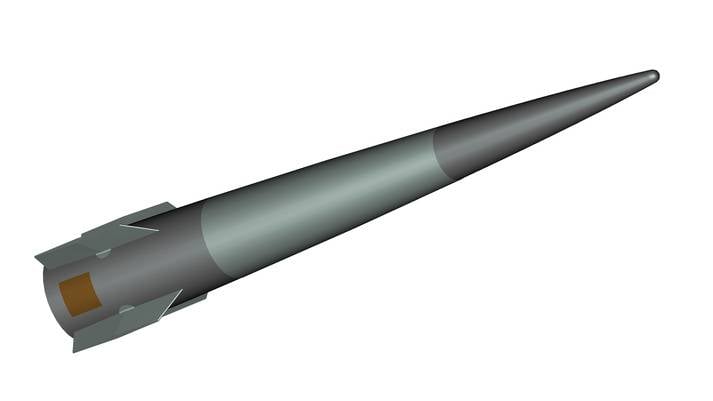
General view of the HVP projectile. Figure BAE Systems / baesystems.com
At the heart of the HVP project was originally the intention of the US Navy to create a promising rail implement. Such an artillery system, using the new principles of throwing projectile, for obvious reasons, can not use standard ammunition. As a result, it was decided to develop an entirely new projectile, designated HVP. To simplify the simultaneous operation of “traditional” and promising guns, it was proposed to create a unified ammunition suitable for use with powder and electromagnetic artillery.
Currently the most powerful naval artillery system in the American navy are 127-mm guns on MK 45 turret installations. Arleigh Burke type destroyers carry one such installation. The newest ship, the USS Zumwalt (DDG-1000), should be equipped with two AGS units with 155 mm caliber guns. The artillery systems of the two models in the future will have to use HVP shells. At the same time, due to the use of some additional means, such ammunition will remain compatible with the "railguns".
The development of the HVP project (Hyper Velocity Projectile - “Hyper Speed Projectile”) began in the 2012 year. The project contractor was BAE Systems. Shortly after the work began, the requirements were changed. The estimated caliber in theory allowed the use of new ammunition, not only with naval guns, but also with ground artillery. The ground forces and the Marine Corps are armed with a significant number of 155-mm guns in towed and self-propelled performance, which is why the HVP product is of great interest not only for the fleet.
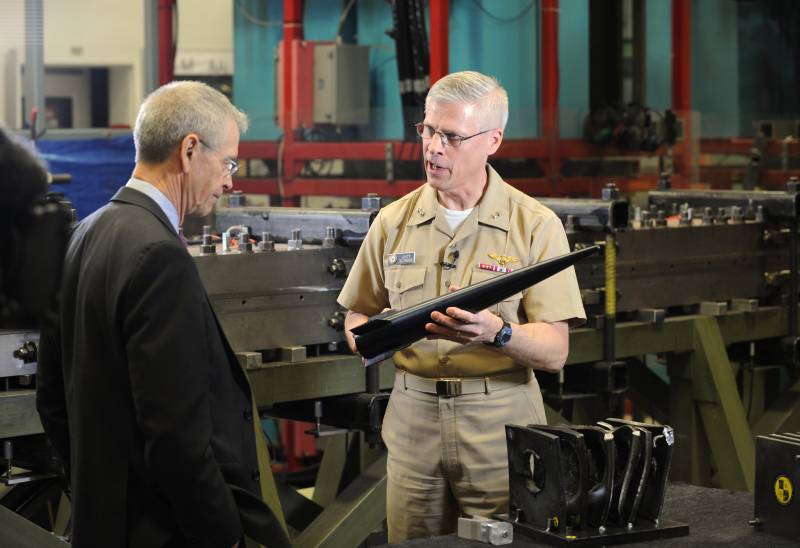
Rear Admiral Matthew Klander (right) shows the HVP product to CBS correspondent David Martin, 4 on April 2014. Photo by US Navy
There are special requirements for a unified projectile compatible with various implements. The customer wants to get a guided munition with its own guidance system, carrying a certain explosive charge. For use with a rail tool capable of accelerating it to ultra-high speeds, the projectile must have appropriate aerodynamic characteristics, as well as be distinguished by high strength of both the hull and internal components. With all this, the HVP product must differ in its low mass: this parameter was set at 23 pounds (10,43 kg).
The universality of the ammunition should lead to some specific technical and operational consequences. So, when launched with a rail gun, HVP should fly 6-7 times faster than sound speed. Traditional gunpowder tools have less high energy characteristics, because of which the velocity of the projectile must reach only M = 3. As a result, other characteristics that are directly related to the effectiveness of the shooting should change. For example, there is a need to equip the projectile warhead. With hypersonic initial speeds, a projectile, even after a long flight, can save significant kinetic energy that can damage the target. Shooting from artillery systems of traditional design does not allow to obtain such advantages, because of which the projectile requires a high-explosive or other warhead.
Despite a noticeable loss in performance compared to a railgun, the combination of the MK 45 ship gun and the HVP standardized projectile should have a positive effect on the shooting results. It is expected that such ammunition can be effectively used when shooting at surface or coastal targets. In addition, the calculated characteristics of the "Hyper velocity projectile" are sufficient to intercept incoming anti-ship missiles. In December last year, one of the reports of the military department indicated that HVP shells with an estimated value of about 25 thousand dollars prove to be one of the most effective means of protection against enemy anti-ship missiles. In terms of cost / efficiency, such systems should be superior to other ship protection systems.
Further development of the HVP projectile will further enhance the fighting qualities of artillery. In particular, it is possible to create ammunition with a new combat load. So, in the 25-pound projectile can be placed 500 three-gram ready attack elements. Due to the high initial velocity of the projectile itself, these elements will be able to form a large “cloud” that is irresistible for enemy missiles. Such capabilities can be used to intercept anti-ship missiles, including when launching them, as well as when destroying other complex targets.
To date, specialists from the US Navy and BAE Systems have managed to carry out the Hyper Velocity Projectile project through several major stages. The overall appearance of the projectile itself and the means of ensuring compatibility with various tools have already been determined. Prototype shells were also manufactured and tested. In the course of the checks, the characteristics of such weapons were partially confirmed, but not all parameters could yet be brought to the required level. Because of this, and for a number of other reasons, the HVP projectile is not yet ready for acceptance into service and delivery to the troops.
Due to the high requirements for flight speed, the promising projectile has a fairly simple hull shape. At the same time, the case, as well as the other elements of the product, is distinguished by the high strength required for operation under the existing loads. The projectile itself has a conical body with a small rounded head section. At the bottom of the projectile placed four controlled plane trapezoidal shape. The layout of the product was not specified, but there is every reason to believe that the head and central compartments can accommodate the homing system and the warhead, and next to the stabilizers are some steering machines. The actual HVP projectile has an 24 inch length (609,6 mm) and weighs 28 pounds (12,7 kg). The ammunition “payload” accounts for 15 pounds (6,8 kg). It is possible to create different warheads that meet the requirements of the customer.
The most interesting feature of the Hyper Velocity Projectile project is the means of ensuring compatibility with tools of various types and classes. In accordance with the wishes of the customer, the ammunition should be used by ship guns of two types, 155-mm land systems and perspective railguns. It is easy to see that such weapons differ from each other not only in the principle of action, but also in caliber. The problem of compatibility of one universal projectile with three guns was solved in an interesting way. Depending on the type of gun, ammunition is proposed to be completed with a detachable pallet of the required type.
For the use of an HVP projectile with 127 caliber guns mm a pallet with a ballistic cap is available. A conical cap covers the head of the projectile. Behind the cap attached several longitudinal elements connected to the tail cup. There are leading belts in the back of the cap and in the glass. After exiting the barrel, the pan is divided into several parts and frees the projectile. In the presence of a pallet, the HVP product is almost the same in size and shape from the standard five-inch shells used by the ship's artillery.
Due to the relatively small caliber HVP can be used with tools caliber 155 mm only in the presence of additional funds that have the appropriate dimensions. Such a pallet consists of three transverse concave discs connected by six longitudinal plates. The tail stabilizers of the projectile are inside the glass with concave elements on the side walls. Unlike the “ship” pallet, the 155-mm system does not completely close the projectile. Its head part stands for the front cut of the pallet. Naturally, the design of the pallet provides easy-opening fasteners to ensure its discharge after leaving the barrel.
The most original and unusual pallet is offered for use with rail implements. In this case, the HVP projectile is placed inside a rectangular structure assembled from three transverse plates with round holes and triangular longitudinal elements. The rear end of this part of the pallet is connected to a large block of great length, having a cut-out of a characteristic shape. The task of the tail block is to ensure the correct interaction with the elements of the gun when fired. After exiting the gun, the unusual tray is dropped.
According to reports, despite the significant difference in the design, all three pallets have similar dimensions and weight. So, the shell together with the pallet has a length of 26 inches (660 mm) and weighs 40 pounds (18,14 kg). Thus, pallets have a mass of not more than 5,5 kg.
To date, some characteristics of promising shells have been published. When using an HVP product with an MK 45 cannon with a Mod 2 version with a 54 barrel of a caliber size, a firing range of at least 40 nautical miles (74 km) is expected. Newer MK 45 Mod 4 guns with a 62 barrel of a caliber long will be able to send the same projectile to a range over 50 nautical miles (93 km). The 155-mm artillery system AGS destroyer USS Zumwalt (DDG-1000) will show a range of more than 70 nautical miles (130 km). When used with the advanced rail cannon, a firing range of more than 100 nautical miles (185 km) is expected. Land artillery units armed with 155-mm guns will be able to attack targets at ranges over 80 km.
The MK 45 shipboard gun mounts, using HVP projectiles, are capable of firing up to 20 rounds per minute. AGS and Railgun will have to show half the rate of fire. Ground 155-mm guns can make up to 6 rounds per minute.
The fundamental possibility of using a unified "Hyper velocity projectile" together with artillery systems of various ranks has already been confirmed in practice. By 2015, the customer and the contractor completed the basic design work and prepared for the test. The first shooting with HVP shells was carried out in 2015 year. In these tests, the ammunition was tested with serial guns caliber 127 and 155 mm. There is also information about the testing of a projectile with an experienced railgun. A few days ago in the American media there were reports about the conduct of regular tests. This time, the Hyper Velocity Projectile was used by the M109 self-propelled howitzer.
At present, according to available data, the authors of the HVP project continue its development and are preparing for new checks. Last year it was reported that in 2018, new tests should be passed, the purpose of which is to demonstrate the capabilities of the ammunition in the context of its actual use by naval forces or land artillery. Successful completion of these tests will allow work to continue, which in the future will open the HVP projectile path into the arsenals of the armed forces.
According to current plans and views, HVP ammunition in the future will be able to significantly improve the efficiency of ship and land artillery. Small size and weight make it possible to obtain high firing range even when launching a projectile from traditional design guns. In addition, the limited size of the warhead and the homing system should increase the probability of hitting the specified target while reducing the so-called. collateral damage.
A shell with a high-explosive fragmentation warhead can be used to destroy surface or coastal targets. It can be considered as a replacement for existing ammunition, characterized by higher performance. We are aware of plans to create a modification of the projectile, carrying a large number of light ready-made destructive elements. Such ammunition will have to find application in the ship's air defense system. Calculations show that the release of damaging elements in combination with other characteristics of the projectile will increase the likelihood of interception of anti-ship missiles, including at long ranges.
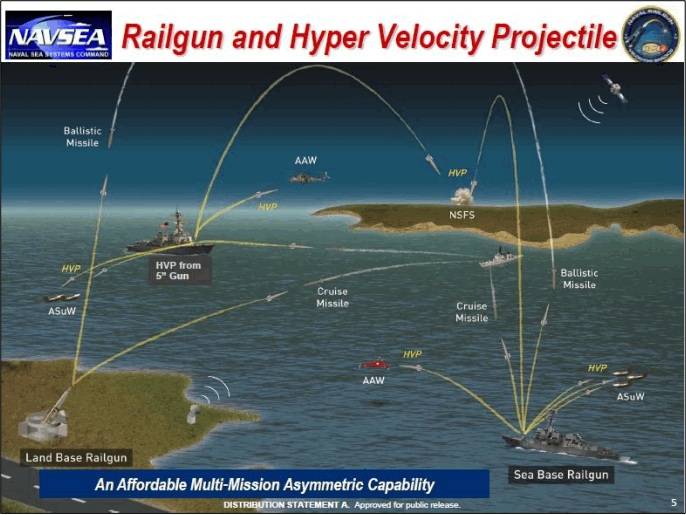
Methods and scopes of perspective rail implements with an HVP projectile. Figure US Navy
In general, at the moment, the project Hyper Velocity Projectile and all related promising programs in the field of naval and land weapons look interesting and allow the Pentagon to hope for getting high results. However, the tasks have been solved only partially. So, as far as we know, rail guns have not yet reached the required level of basic characteristics, and the use of HVP projectiles in other areas is still limited to field tests. In addition, the current project has other problems. With all its advantages, the new product is distinguished by too high a price. A shell worth 25 thousand dollars, even showing the highest performance, runs the risk of being heavily criticized by congressmen. In addition, this price is unlikely to please the officials of the military department engaged in finance.
Despite the problems of a technical and technological nature, practical difficulties and the overall complexity of the work inherent in all new projects, the Pentagon and BAE Systems continue the development of a unified ammunition Hyper Velocity Projectile. To date, this product has been put to the test and tested together with a new type of artillery systems. In case of successful completion of the project, the US armed forces will receive a new convenient tool for solving combat missions. However, the completion of all necessary work will take some time and the corresponding costs.
On the materials of the sites:
http://baesystems.com/
https://news.usni.org/
http://realcleardefense.com/
http://nextbigfuture.com/
http://warandpeace.ru/
http://globalsecurity.org/
http://navweaps.com/
The full report of the Navy Lasers, Railgun, and Hypervelocity Projectile: Background and Issues for Congress:
https://news.usni.org/2017/03/23/24782-congress-navy-laser-railgun-hypervelocity-projectiles
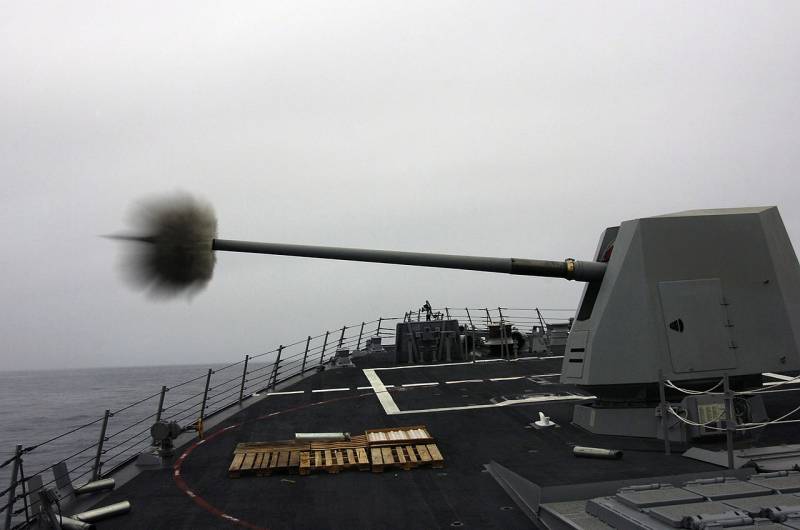
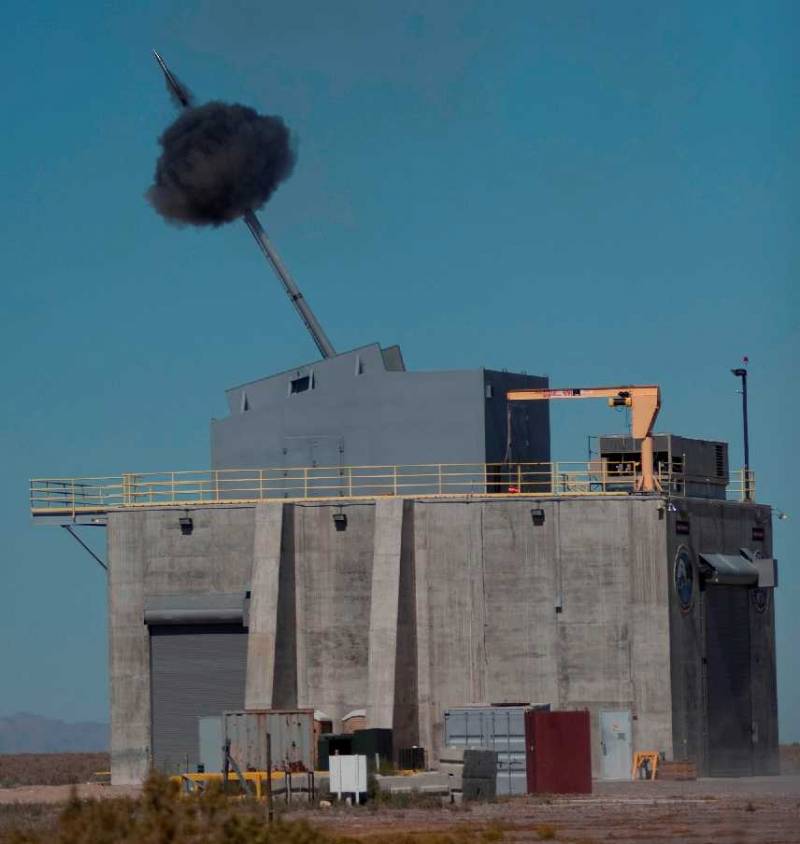
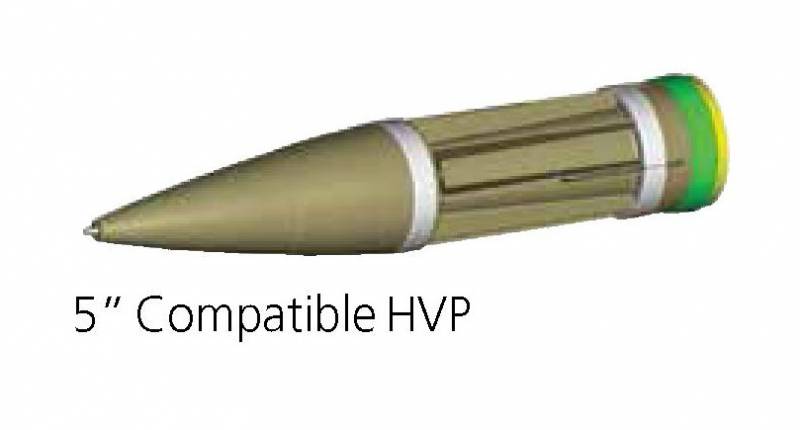
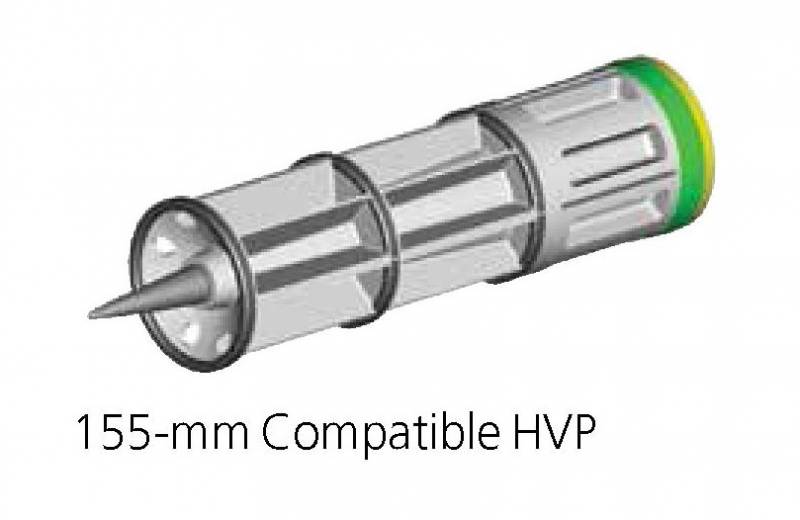
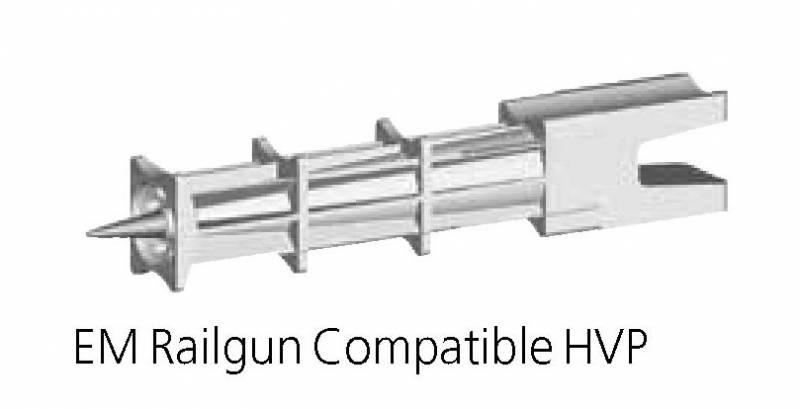
Information